| Feekes growth scale |
Identification and Crop Management Recommendations |
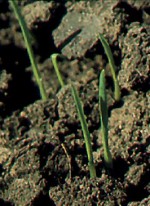
Feekes 1.0
Emergence
(one shoot formed) |
If desired, number of leaves present on the first shoot can be designated with a decimal. For example, 1.3 is a single shoot with three leaves unfolded. Without a doubt, the most significant event in achieving high yield of grain and/or forage in wheat is stand establishment. Planting high quality seed of an adapted wheat variety in a fertile, well prepared seedbed with enough moisture to achieve a rapid, uniform stand is a significant step in achieving acceptable yields.
Late planted wheat has less time to tiller and should be planted at a higher rate to compensate for fewer tillers. If early forage production is a goal, producers should increase seeding rates and depend less on tiller formation to produce early forage growth. |
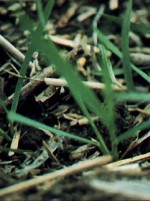
Feekes 2.0
Beginning of tillering |
A tiller is a shoot which originates in the axil of a leaf or at the coleoptilar node. Tillers share the same root mass with the original shoot or main stem. Once established, secondary tillers may arise from the axils of the primary tillers; tertiary tillers may develop from the axils of secondary tillers, etc.
During tillering, the major management consideration is whether stands are adequate to achieve yield goals. Management inputs will not compensate for skippy or erratic stands caused by insects, poor seed quality, herbicide injury, etc. If stands are thin, but uniform, an early nitrogen (N) application may enhance the rate of tillering, potentially increasing the number of heads per square foot. Care must be taken with fall N application. If heat units are available, excess N applied at this time leads to a lush, vegetative growth which makes the crop more susceptible to winterkill, foliar fungal disease, and aphid injury. Adequate phosphorus (P) is strongly related to rooting and tiller development. If tiller development is a historic problem in a given field, close attention must be given to P soil test recommendations prior to planting. |
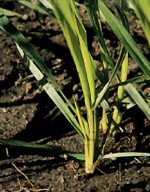
Feekes 3.0
Tillers formed |
Winter wheat can continue to tiller for several weeks. Depending upon planting date and weather conditions, tillering can either be interrupted by or completed prior to the onset of winter dormancy. Most of the tillers that contribute to grain yield potential are completed during this stage. Leaves begin to twist spirally. Many winter wheats are prostrate or "creeping" at stage 3.
Major yield potential loss can occur from weed infestation during tiller formation, as weeds compete for light, water and nutrients. Once the wheat has achieved full canopy, little problem is experienced from weeds. Weed control decisions should be made before or during Feekes 3.0. The herbicide metribuzin may be applied for postemergence grass and broadleaf weed control during this growth stage on tolerant wheat varieties. In most cases, plants should have at least 4 tillers and be actively growing before application of this herbicide. The herbicide 2,4-D and similar phenoxy herbicides should not be applied until wheat is fully tillered, or after Feekes 3.0.
Growers should carefully scout for aphid and other insect infestations during Feekes 2.0 and 3.0, as stress from insect injury can reduce tiller formation. Control thresholds are much lower on small plants than later when plants are larger. |
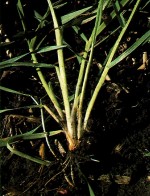
Feekes 4.0
Beginning of
erect growth,
leaf sheaths
lengthen |
Most tillers have been formed by this stage, and the secondary root system is developing. Winter wheats which may have a prostrate growth habit during the development of vegetative parts begin to grow erect. Leaf sheaths thicken. The key management step at Feekes 4.0 is continued scouting for insect and weed infestations. Some growers initiate grazing during Feekes 4.0. |
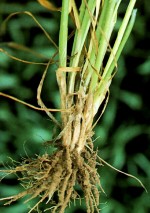
Feekes 5.0
Leaf sheaths
strongly erect |
At this stage, the wheat plant becomes strongly erect. All meaningful tiller development has ceased. Many varieties of winter wheat which are creeping or low-growing during tillering, grow vertically at this stage. The vertical growth habit is caused by a pseudo or false stem formed from sheaths of leaves. In early planted wheat in southern areas of the U.S., this stage can occur prior to the onset of winter dormancy.
Further development of the winter wheat plant requires vernalization, or a period of cool weather. After the appropriate amount of chilling, followed by the resumption of growth, the growing point (which is located below the soil level at the crown) differentiates. This means that all leaves have been formed and the growing point, which generates new cells for the plant, will begin to develop an embryonic head. At this stage of growth, the size of heads, or number of spikelets per spike, is determined. No effect on yield is expected from tillers developed after Feekes 5.0. Nitrogen applied at Feekes 5.0 can affect number of seed per head and seed size, but will not likely affect number of heads harvested. This is an ideal stage of growth for the spring topdress N application as later applications will not affect the potential number of seed per head.
Irrigation management can be critical during the spikelet differentiation process. Extreme stress during this differentiation process can reduce potential number of seeds per head, which is an important component of yield. Wheat stressed during the head differentiation process at Feekes 5.0 will have blank portions of the head, frequently on the ends.
Take great care with grazing operations, particularly on short wheats, during this growth stage. Final plant size, leaf area, and yield are closely related to the severity of grazing. This is true of wheat harvested for grain and wheat intended for graze-out. Tall wheats are more tolerant of severe grazing at this stage of growth. Rotate cattle with a goal of leaving a minimum 3 to 4 inches of green leaf area going into Feekes 6.0. |
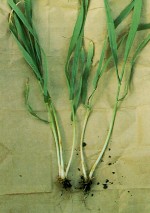
Feekes 6.0
First node visible |
This stage of growth is easy to identify. Feekes 6.0 will not occur prior to the onset of cold weather, as vernalization is required in winter wheats prior to spikelet differentiation. Prior to Feekes 6.0, the nodes are all formed, but are sandwiched together so that they are not readily distinguishable to the naked eye. At 6.0 the first node is swollen and appears above the soil surface. Above this node is the head, or spike, which is being pushed upwards to eventually be exerted from the boot. The true stem is now forming. The spike at this stage is fully differentiated, containing all potential spikelets and florets or seed forming branches.
Growers should look carefully for the first node to emerge. It can usually be seen and felt. A sharp knife or razor blade is useful to split stems to determine the location of the developing head. The stem is hollow in most wheat varieties behind this node. By Feekes 6.0, essentially all weed control applications have been made. Do not apply phenoxy herbicides such as 2,4-D, Banvel or MCPA after Feekes 6.0, as these materials can be translocated into the developing spike, causing sterility or distortion. Sulfonyl urea herbicides are safe at this growth stage, but for practical reasons, weed control should have been completed by now.
All grazing should cease by Feekes 6.0. Mechanical injury by livestock to the spikes at this time means direct loss of grain yield. But a more significant effect on potential yield comes from loss of leaf area to grazing at this stage.
Small grains can still show good response to N topdressed at this time, although yield responses will be better at Feekes 5.0 as head size can no longer be affected by fertilizer application. Mechanical injury to wheat can occur from fertilizer applicators at this stage of growth, but response to applied N will usually more than compensate for the damage if soil N is deficient. |
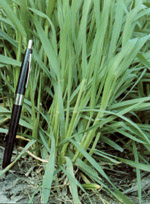
Feekes 7.0
Second node
visible
next to last
leaf visible. |
This stage is characterized by the rapid expansion of the spike and the appearance of a second node above the soil surface. |
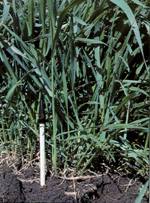
Feekes 8.0
Flag leaf visible |
This growth stage begins when the last leaf (flag leaf) beings to emerge from the whorl. This stage is particularly significant because the flag leaf makes up approximately 75 percent of the effective leaf area that contributes to grain fill. When the flag leaf emerges, at least 3 nodes are visible above the soil surface; occasionally a fourth node can be found. To confirm that the leaf emerging is the flag leaf, split the leaf sheath above the highest node. If the head and no additional leaves are found inside, stage 8.0 is confirmed.
At Feekes 8.0, the grower should decide whether to use foliar fungicides or not. This decision should be based upon the following considerations:
- Is a fungal disease present in the crop?
- Does the crop have resistance to the fungal disease, or is the disease spreading rapidly?
- Does the crop yield potential warrant the cost of application of the fungicide in question to protect it?
- Is the crop under stress?
If a positive answer applies to the first three questions, and a negative response to the last, plans should be made to protect the crop, especially the emerging flag leaf, from further damage. Check product labels and apply as soon as possible. In most situations, the greatest return to applied foliar fungicides comes from application at Feekes stage 8.0 to 9.0. There is a considerable debate about pre-emptive applications of fungicides to prevent future infestations of fungal diseases. In certain high disease and high yield environments, this may be justified.
Nitrogen applications at Feekes 8.0 and later can enhance grain protein levels, but are questionable with respect to added yield.
Irrigation scheduling becomes most critical between Feekes 8.0 and mid-grain (Feekes 11.1). The crop should not be stressed from about 10 days prior to bloom through the late milk stage. Feekes 8.0 marks a point in the development of the wheat plant beyond which every effort should be made to apply water to prevent loss in grain yield potential. |
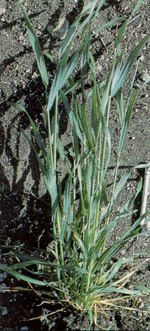
Feekes 9.0
Ligule of flag
leaf visible. |
Stage 9.0 begins when the flag leaf is fully emerged from the whorl. From this point on, leaves are referred to in relation to the flag leaf, i.e.; the first leaf below the flag leaf is F-I, the second leaf below is F-2, etc. The wheat plant typically produces 7 to 9 true leaves, not inclusive of leaves on the tillers. After flag leaf emergence, army worms can seriously damage yield potential. |
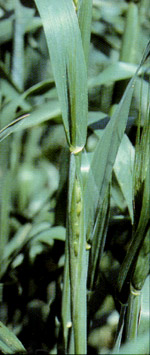
Feekes 10.1
Boot stage
awns visible
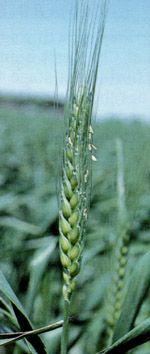
Feekes 10.5.1
Beginning flowering
| The head is fully developed and can be easily seen in the swollen section of the leaf sheath below the flag leaf. The Feekes growth scale at stage 10 is divided as follows:
Feekes 10.0 boot stage
Feekes 10.1 awns visible, heads emerging through slit of flag leaf sheath
Feekes 10.2 heading 1/4 complete
Feekes 10.3 heading 1/2 complete
Feekes 10.4 heading 3/4 complete
Feekes 10.5 heading complete
Feekes 10.5.1 beginning flowering
Feekes 10.5.2 flowering complete to top of spike
Feekes 10.5.3 flowering complete to base of spike
Feekes 10.5.4 kernels watery ripe
Wheat is largely self pollinating. Most florets are pollinated before anthers are extruded. Although tillers have developed over a several week period, bloom in a given wheat plant is usually complete in a few days. After Feekes stage 10.5.3, remaining growth stages refer to ripeness or maturity of the kernel. |
Feekes 11.0
Ripening |
Feekes 11.1 milky ripe
Feekes 11.2 mealy ripe
Feekes 11.3 kernel hard
Feekes 11.4 harvest ready
Bloom occurs 4 to 5 days after heading. The grain fill period of wheat varies somewhat, depending upon climate. It is typically as little as 30 days in high stress environments, and may exceed 50 days in high yield, low stress environments. |
Wheat mature and harvest-ready-Feekes 11.4
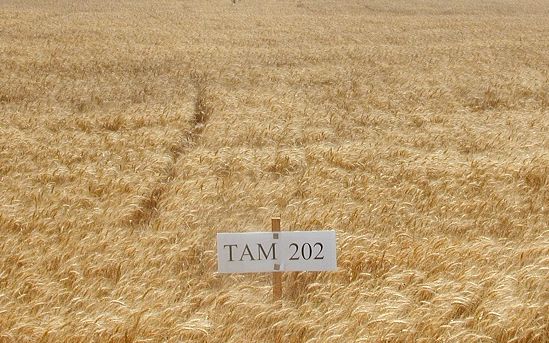 |
First printed in Better Crops With Plant Food, Summer 1992 Pages 12 - 17. It was re-published by the Potash & Phosphate Institute (PPI), 655 Engineering Drive, Suite 110, Norcross, GA 30092-2821. |